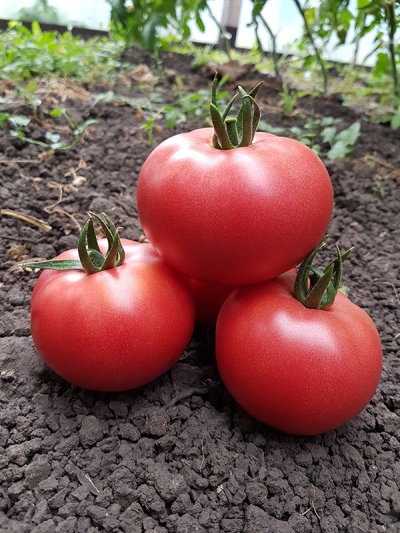
- Authors: Barbaritskiy A. Yu. (Nutritech Yug LLC)
- Year of approval: 2018
- Category: hybrid
- Growth type: indeterminate
- Appointment: fresh consumption
- Ripening period: early
- Ripening time, days: 95-100
- Growing conditions: for foil greenhouses, for greenhouses
- Transportability: high
- Bush size: tall
Cetus is a hybrid tomato variety bred by Russian breeders and approved for use in 2018. Despite the relative novelty, Cetus quickly won the hearts of Russian gardeners, and although there is still quite a bit of information about this variety, it is already possible to draw some conclusions about the taste and survival rate of tomatoes.
Description of the variety
The bush is of an indeterminate type, tall, reaching a height of 2 m, but it looks quite compact. Leaves of medium length, green, formed in small quantities. The variety is characterized by short internodes, which simplifies farming. Flowers have a high vitality, and this explains the high percentage of set. Already the first cluster forms up to 5 fruits; in total, 6-8 tomatoes are formed in the clusters. Also, the bush is distinguished by a developed root system.
The main qualities of the fruit
When unripe, the fruits are light green, when ripe they turn pink. The mass of tomatoes is 200 g, the fruits are flat-round, slightly ribbed in shape. The inflorescence is simple, the stalk is articulated.
The presented varieties are characterized by high transportability and good keeping quality. And although a lot of juicy moisture is formed in the pulp, the dense skin allows tomatoes to be stored for a long time without losing their presentation and taste.
Taste characteristics
Judging by the gardeners' reviews, these tomatoes are distinguished by their excellent taste and pronounced aroma. The pulp is dense, low-seeded, and therefore the fruits are recommended for fresh consumption. The taste is revealed especially well when adding Cetus tomato to a fresh vegetable salad.
Ripening and fruiting
The presented variety belongs to varieties with an early ripening period. The taste of the first tomatoes can be appreciated within 95-100 days from the start of germination. Usually the harvesting period is September-October.
Yield
This is a high-yielding variety that allows you to harvest up to 16 kg of tomatoes from 1 sq. m.
The timing of planting seedlings and planting in the ground
The yield will be higher if sowing is carried out in March-April, then harvesting will be in September. A short turnover allows you to quickly get ready-made tomatoes, but they will be smaller and productivity will be lower. This is a hybrid variety, so every season you need to buy a new planting material - the seeds from your vegetables are not suitable for cultivation. Otherwise, the rules for growing seedlings are the same as for other varieties.
So, first of all, you should prepare the soil, it is recommended to use a ready-made, purchased substrate. Put it in a container, sprinkle with water and deepen the seeds by 1-1.5 cm. After that, moisten the planting site again, cover the container with a film and remove it in a dark place. When the first shoots hatch, the film can be removed, and the container can be placed in a lighted place.
Seedlings of the presented variety dive when two leaves appear, and a week before transplanting, they begin to harden the plants. To do this, they are taken out into the fresh air, each day increasing the time they spend outside.

Growing tomato seedlings is an extremely important process, because it largely depends on whether the gardener will be able to harvest at all. All aspects must be taken into account, from seedbed preparation to planting in the ground.
Landing scheme
It is customary to grow the Cetus variety in a greenhouse, as it is very thermophilic. To make the seedlings feel comfortable and bring a solid harvest in the future, plant them at a distance of 35-45 cm, and leave a distance of 55-75 cm between the rows.

Growing and care
The most important rule when cultivating this tomato is its garter to the support. If the plant is not tied up in time, then it runs the risk of breaking off under the weight of the fruit. The variety is undemanding for watering, since it has a developed root system, which also provides the shoots with a sufficient amount of nutrients. The variety also tolerates high humidity.
It differs in heat and cold resistance, and therefore it can be grown both in the south of Russia and in areas of risky farming, that is, the culture is not afraid of extreme conditions. Cetus is tolerant to common tomato diseases, it is also resistant to fruit cracking, however, as a preventive measure, it is important to remove weeds in a timely manner.
Another interesting property of this tomato is the ability to grow it in glass structures throughout the year.




A plant needs different micronutrients at each stage of growth. All fertilizers can be divided into two groups: mineral and organic. Folk remedies are often used: iodine, yeast, bird droppings, eggshells.
It is important to observe the rate and period of feeding. This also applies to folk remedies and organic fertilizers.



























































































